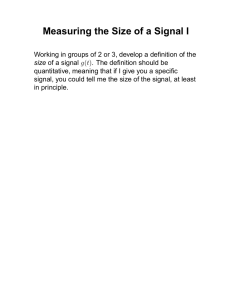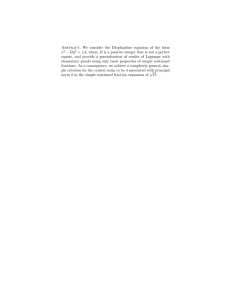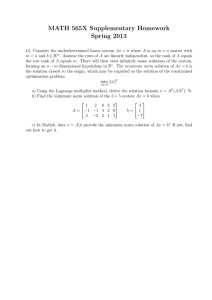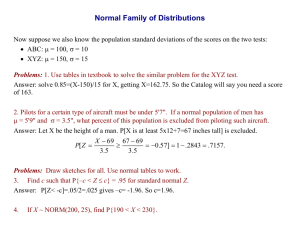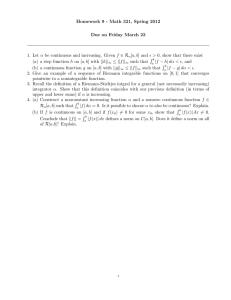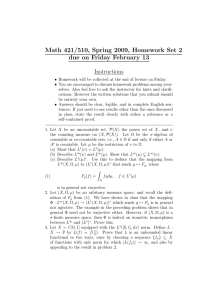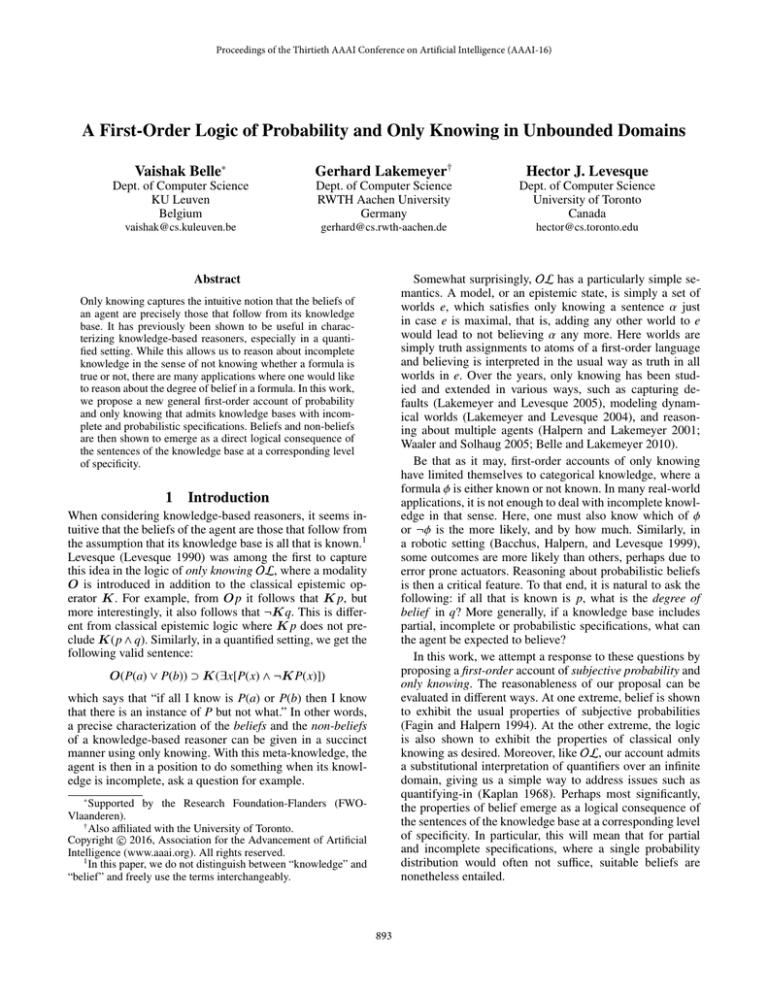
Proceedings of the Thirtieth AAAI Conference on Artificial Intelligence (AAAI-16)
A First-Order Logic of Probability and Only Knowing in Unbounded Domains
Vaishak Belle∗
Gerhard Lakemeyer†
Hector J. Levesque
Dept. of Computer Science
KU Leuven
Belgium
Dept. of Computer Science
RWTH Aachen University
Germany
Dept. of Computer Science
University of Toronto
Canada
vaishak@cs.kuleuven.be
gerhard@cs.rwth-aachen.de
hector@cs.toronto.edu
Somewhat surprisingly, OL has a particularly simple semantics. A model, or an epistemic state, is simply a set of
worlds e, which satisfies only knowing a sentence α just
in case e is maximal, that is, adding any other world to e
would lead to not believing α any more. Here worlds are
simply truth assignments to atoms of a first-order language
and believing is interpreted in the usual way as truth in all
worlds in e. Over the years, only knowing has been studied and extended in various ways, such as capturing defaults (Lakemeyer and Levesque 2005), modeling dynamical worlds (Lakemeyer and Levesque 2004), and reasoning about multiple agents (Halpern and Lakemeyer 2001;
Waaler and Solhaug 2005; Belle and Lakemeyer 2010).
Be that as it may, first-order accounts of only knowing
have limited themselves to categorical knowledge, where a
formula φ is either known or not known. In many real-world
applications, it is not enough to deal with incomplete knowledge in that sense. Here, one must also know which of φ
or ¬φ is the more likely, and by how much. Similarly, in
a robotic setting (Bacchus, Halpern, and Levesque 1999),
some outcomes are more likely than others, perhaps due to
error prone actuators. Reasoning about probabilistic beliefs
is then a critical feature. To that end, it is natural to ask the
following: if all that is known is p, what is the degree of
belief in q? More generally, if a knowledge base includes
partial, incomplete or probabilistic specifications, what can
the agent be expected to believe?
In this work, we attempt a response to these questions by
proposing a first-order account of subjective probability and
only knowing. The reasonableness of our proposal can be
evaluated in different ways. At one extreme, belief is shown
to exhibit the usual properties of subjective probabilities
(Fagin and Halpern 1994). At the other extreme, the logic
is also shown to exhibit the properties of classical only
knowing as desired. Moreover, like OL, our account admits
a substitutional interpretation of quantifiers over an infinite
domain, giving us a simple way to address issues such as
quantifying-in (Kaplan 1968). Perhaps most significantly,
the properties of belief emerge as a logical consequence of
the sentences of the knowledge base at a corresponding level
of specificity. In particular, this will mean that for partial
and incomplete specifications, where a single probability
distribution would often not suffice, suitable beliefs are
nonetheless entailed.
Abstract
Only knowing captures the intuitive notion that the beliefs of
an agent are precisely those that follow from its knowledge
base. It has previously been shown to be useful in characterizing knowledge-based reasoners, especially in a quantified setting. While this allows us to reason about incomplete
knowledge in the sense of not knowing whether a formula is
true or not, there are many applications where one would like
to reason about the degree of belief in a formula. In this work,
we propose a new general first-order account of probability
and only knowing that admits knowledge bases with incomplete and probabilistic specifications. Beliefs and non-beliefs
are then shown to emerge as a direct logical consequence of
the sentences of the knowledge base at a corresponding level
of specificity.
1
Introduction
When considering knowledge-based reasoners, it seems intuitive that the beliefs of the agent are those that follow from
the assumption that its knowledge base is all that is known.1
Levesque (Levesque 1990) was among the first to capture
this idea in the logic of only knowing OL, where a modality
O is introduced in addition to the classical epistemic operator K. For example, from O p it follows that K p, but
more interestingly, it also follows that ¬Kq. This is different from classical epistemic logic where K p does not preclude K(p ∧ q). Similarly, in a quantified setting, we get the
following valid sentence:
O(P(a) ∨ P(b)) ⊃ K(∃x[P(x) ∧ ¬KP(x)])
which says that “if all I know is P(a) or P(b) then I know
that there is an instance of P but not what.” In other words,
a precise characterization of the beliefs and the non-beliefs
of a knowledge-based reasoner can be given in a succinct
manner using only knowing. With this meta-knowledge, the
agent is then in a position to do something when its knowledge is incomplete, ask a question for example.
∗
Supported by the Research Foundation-Flanders (FWOVlaanderen).
†
Also affiliated with the University of Toronto.
c 2016, Association for the Advancement of Artificial
Copyright Intelligence (www.aaai.org). All rights reserved.
1
In this paper, we do not distinguish between “knowledge” and
“belief” and freely use the terms interchangeably.
893
Intuitively, given norm(d, V, r), r can be seen as the normalization of the weights of worlds in V in relation to the
set of all worlds W as accorded by d. Here, equal(d, V, b)
expresses that the weight accorded to the worlds in V is b,
and finally bound(d, V, b) ensures the weight of worlds in V
is bounded by b. In essence, although W is uncountable, the
conditions bound and equal admit a well-defined summation
of the weights on worlds:
Theorem 2 :
Suppose d is a distribution, and let
V = {w ∈ W | d(w) 0} . For any number b ≥ 0, if
bound(d, W, b) then V is countable.
Proof:
Consider the sequence of sets of worlds Vi =
{w ∈ V | d(w) ≥ 1/i} for positive integers i. It is easy to see
that V = ∪Vi , a property we denote by (∗). Now suppose V is uncountable. Then there is some > 0 such
that Ve = {w ∈ V | d(w) ≥ } is infinite. (For otherwise we
could enumerate V by enumerating Vi starting at i = 1 using (∗).) Now, consider any countably infinite sequence of
worlds
w j taken from Ve . Since d(w j ) ≥ for all w j , the
sum ∞j=1 d(w j ) is clearly unbounded, contradicting the assumption that W is bounded by b.
We structure our work as follows. We begin by introducing the logic OBL (= OL+ degrees of belief modality). Then, we turn to properties and example specifications,
OBL’s relation to OL, discuss related work, and conclude.
2 The Logic OBL
Syntax
The non-modal fragment of OBL consists of standard firstorder logic with = (that is, connectives {∧, ∀, ¬}, syntactic
abbreviations {∃, ≡, ⊃}) and a countably infinite set of standard names N, which includes the set of rationals as a subsort. As we shall see, these standard names will serve as a
fixed domain of discourse, permitting a substitutional interpretation for quantifiers. To keep matters simple, function
symbols are not considered in this language. We call a predicate other than =, applied to first-order variables or standard names, an atomic formula. We write αnx to mean that
the variable x is substituted in α by a standard name n. If all
the variables in an atom are substituted by standard names,
then we call it a ground atom. Let P be the set of ground
atoms in OBL.
OBL has two epistemic operators: B(α: r) is to be read
as “α is believed with a probability r,” where r is a rational
number. Next, the modality O(α1 : r1 , . . . , αk : rk ), where αi
does not mention modalities and ri is a rational, is to be read
as “all that is believed is: α1 with probability r1 , . . . , and αk
with probability rk .” We also use Kα, to be read as “α is
known,” as an abbreviation for B(α: 1). We write Oα, to be
read as “α is all that is known,” to mean O(α: 1).
A formula not mentioning modalities is called objective,
and a formula where all predicate symbols appear within the
scope of a modal operator is called subjective.
Corollary 3: Suppose d is as above, V ⊆ W is infinite, and
bound(d, V, b). Then {w ∈ V | d(w) 0} is countable.
Theorem 4: Suppose V ⊆ W is infinite, d is a distribution, b
a number and equal(d, V, b) holds. Thenthere is an infinite
sequence w1 , . . . , with wi ∈ V such that ∞
i=1 d(wi ) = b.
Proof: Since equal(d, V, b), by definition, bound(d, V, b).
By Corollary 3, U = {w ∈ V | d(w) 0} is countable. Consider any sequence consisting of all worlds
wi ∈ U. We
recall the property that for any series ∞
i=1 ai , where ai is
nonnegative,
the series converges iff it is bounded. Then, we
and so it conhave that ∞
i=1 d(wi ) is
bounded by assumption
verges, and suppose ∞
i=1 d(wi ) = b . It is easy to see that if
b b, then equal(d, V, b) is a contradiction.
Semantics
The semantics is given in terms of possible worlds. Here, a
world w maps the ground atoms in P to {0, 1}, and let W be
the set of all worlds. By a distribution d we mean a function
from W to the set of positive reals R≥0 . An epistemic state
e is defined as a set of distributions. By a model, we mean a
pair (e, w).
As can be surmised, the definition of a distribution here
does not immediately lead to a probability distribution in the
usual sense. To obtain probability distributions, we appeal to
three simple conditions that will be used in the semantics:
We are now prepared for a semantics. Given α ∈ OBL
and a model (e, w), the semantic rules are as follows:
• e, w |= p iff w[p] = 1;
• e, w |= n1 = n2 iff n1 and n2 are the same standard names;
• e, w |= ¬α iff e, w |= α;
• e, w |= α ∧ β iff e, w |= α and e, w |= β;
• e, w |= ∀xα iff e, w |= αnx for all names n;
• e, w |= B(α: r) iff
for all d ∈ e, norm(d, {w | e, w |= α} , r);
• e, w |= O(α1 : r1 , . . . , αk : rk ) iff
for all d, d ∈ e iff norm(d, {w | e, w |= α1 } , r1 ),
. . . , norm(d, {w | e, w |= αk } , rk ).
We often write e |= α when the world is irrelevant (that is,
when α is a subjective formula), and write w |= α when the
epistemic state is irrelevant (that is, when α is an objective
formula). Given any set of sentences Σ, we write Σ |= α
(read: “Σ entails α”) to mean that if e, w |= β for every β ∈ Σ
then e, w |= α. Finally, we write |= α (read: “α is valid”)
to mean {} |= α. We let true denote a tautologous sentence,
such as ∀x(x = x), and let false denote its negation.
Definition 1: Let d be any distribution, V ⊆ W any set
of worlds, and r any real number. We define conditions
bound, equal and norm as follows:
• norm(d, V, r) iff there is a number b 0 such that
equal(d, V, b × r) and equal(d, W, b);
• equal(d, V, r) iff bound(d, V, r) and there is no r < r
such that bound(d, V, r );
• bound(d, V, r) iff there is no k, w1 , . . . , wk ∈ V such that
k
d(wi ) > r.
i=1
894
3
norm(d, Wα∧¬β , r ). So for some b 0,
equal(d, Wα∧β , b × r), equal(d, Wα∧¬β , b × r ) and
equal(d, W, b) hold. Since Wα∧β ∩ Wα∧¬β is empty, and
Wα∧β ∪Wα∧¬β −Wα is empty, we have equal(d, Wα , b×
r + b × r ). Hence norm(d, Wα , r + r ) for every d ∈ e, and
so e |= B(α: r + r ).
Properties of Belief
In this section, we argue for the reasonableness of our semantic rules for the B modality. (A discussion on only
knowing is deferred to Section 5.) To that end, it will be
convenient to identify epistemic states that can interpret every atomic event:
Definition 5: We say e is measurable iff for every d ∈ e, for
every atom p, there is a r ≥ 0 such that {d} |= B(p: r).
• if r is a negative number then B(α: r) is unsatisfiable
Proof: If e |= B(α: −r) where r is a positive real, then
for every d ∈ e, norm(d, Wα , −r) which is impossible by
the definition of d that maps worlds to positive reals.
As we now show, measurability2 is intimately related to
the notion of a “reasonable” epistemic state, in that valid
sentences are always known. In the sequel, given α and e,
we write Wαe to mean the set {w | e, w |= α}, often dropping
the superscript when the context is clear.
• if |= α ≡ β, then |= B(α: r) ≡ B(β: r)
Proof: For any e, and for every d ∈ e, since Wα = Wβ ,
if norm(d, Wα , r) then norm(d, Wβ , r) and vice versa.
Thus, e |= B(α: r) ⊃ B(β: r) and vice versa.
Theorem 6: e is measurable iff e |= B(true: 1).
Proof: Suppose e is measurable. Then for every d ∈ e, for
every p, there is some r, such that {d} |= B(p: r). That is,
norm(d, W p , r), and so for some b 0, equal(d, W p , b × r)
and equal(d, W, b). Thus, for every d ∈ e, norm(d, W, 1)
and so e |= B(true: 1).
Conversely, suppose e |= B(true: 1) and so, for every
d ∈ e, norm(d, W, 1), that is, equal(d, W, b) for some positive b. Then for any ground atom p, bound(d, W p , b) since
W p ⊆ W. By Corollary 3, V = {w ∈ W p | d(w) 0}
is countable, and since bounded countable series of nonnegative terms converge (see argument for Theorem 4), let b∗
be such that equal(d, W p , b∗ ). So, norm(d, W p , b∗ /b). Since
this applies to all d ∈ e, clearly e is measurable.
• |= B(α: r) ∧ B(β: r ) ∧ B(α ∧ β: r ) ⊃ B(α ∨ β: r + r − r )
OBL satisfies the addition law of probability.
Knowledge
As in OL (Levesque and Lakemeyer 2001), the following
properties of knowledge hold, which include the universal
and existential versions of the Barcan formula:
• |= Kα ∧ K(α ⊃ β) ⊃ Kβ
Proof: Suppose e |= Kα and e |= K(α ⊃ β). Then for
all d ∈ e, norm(d, Wα , 1) and norm(d, Wα⊃β , 1). So for
every d ∈ e, there is a b 0 such that equal(d, Wα , b),
equal(d, Wα⊃β , b) and equal(d, W, b). In particular, because equal(d, Wα , b) and equal(d, W, b), thereis an infinite sequence w1 , . . . with wi ∈ Wα such that4 d(wi ) =
b and for w Wα , d(w) = 0. (Otherwise, equal(d, W, b)
cannot be true.) Moreover, there is no finite sequence
w1 , . . . , wk with wi ∈ Wα such that d(w1 ) + . . . +
d(wk ) > b. An analogous observation can be made for
equal(d, Wα⊃β , b), and so there is an infinite
sequence
w1 , . . . with wi ∈ Wα ∩ Wα⊃β such that d(wi ) = b, and
for w Wα ∩ Wα⊃β , d(w) = 0. Since Wβ ⊇ Wα ∩ Wα⊃β
and d(w) = 0 for w ∈ Wβ − Wα ∩ Wα⊃β , there is
an infinite sequence w1 , . . . with wi ∈ Wβ such that
d(wi ) = b but no finite sequence w1 , . . . , wk such that
d(w1 ) + . . . + d(wk ) > b. That is, equal(d, Wβ , b) and because equal(d, W, b), we get norm(d, Wβ , 1) . This holds
for every d ∈ e. So e |= Kβ.
Consequently, we obtain the following properties for B
regarding truth:3
• ¬Ktrue is satisfiable
Proof: Suppose d maps every w ∈ W to an integer > 0.
Then there is no b such that bound(d, W, b) holds, and so
also not equal(d, W, b). Thus, for any e such that d ∈ e,
e |= B(true: 1).
• |= B(true: 1) ⊃ B(false: 0)
Proof:
Suppose e |= B(true: 1). Then for every
d ∈ e, norm(d, W, 1) and so norm(d, {} , 0), that is, e |=
B(false: 0).
Additivity and Equivalence
Beyond truth and falsehood, B can be shown to exhibit the
following reasonable properties (as in, for example, (Fagin
and Halpern 1994)):
• |= ∀xKα ⊃ K∀xα
Proof: Suppose e, w |= ∀xKα. Then, e, w |= Kαnx for
all names n. Thus, for all d ∈ e, norm(d, Wαnx , 1) for all
names n, and so norm(d, W∀xα , 1). So e, w |= K∀xα.
• |= B(α ∧ β: r) ∧ B(α ∧ ¬β: r ) ⊃ B(α: r + r )
Proof: Suppose e |= B(α ∧ β: r) and e |= B(α ∧ ¬β: r ).
This means that for all d ∈ e, norm(d, Wα∧β , r) and
• |= K∀xα ⊃ ∀xKα
2
Our terminology is such because this property can be seen to
assign a probability measure to W p = {w | w |= p} for every atom
p. Roughly, this is a definition to realize the measurable case in the
sense of (Fagin and Halpern 1994).
3
Of course, if needed, we can simply restrict ourselves to measurable epistemic states by means of which truth is always believed
with probability 1.
• |= ∃xKα ⊃ K∃xα but |= K∃xα ⊃ ∃xKα
The converse of the Barcan does not hold for the existential: knowing that α holds for someone does not imply
knowing that individual.
4
895
We simply write
d(wi ) for
∞
i=1
d(wi ).
• |= K p ∧ B(q: r) ⊃ B(p ∧ q) ≥ r
That is, beliefs and knowledge can be combined freely.
Introspection
For introspection, we prove general versions involving
B(α: r) for arbitrary numbers r, and so the usual Kproperties (Fagin et al. 1995) come out as special cases.
A less obvious property in the context of a universally
quantified formula is the following:
• |= B(α: r) ⊃ KB(α: r)
Proof: Suppose e |= B(α: r), and so for all d ∈ e,
norm(d, W, 1). By assumption, also note that WB(α:r) =
W. (If e |= B(α: r), WB(α:r) would be empty.) Therefore,
for every d ∈ e, norm(d, WB(α:r) , 1). So, by definition,
e |= KB(α: r).
Proposition 8: Suppose n is any name, and r {0, 1}.
Then |= B(∀xP(x): r) ⊃ B(P(n): r) but |= B(∀xP(x): r) ⊃
BP(n) ≥ r.
Proof: Suppose e |= B(∀xP(x): r). Suppose w is a world
such that w |= P(n ) for every name n , and w is a world
such that w |= P(n) ∧ ¬P(n ) for every name n n. Let d
map w to r and w to 1 − r, and 0 to all other worlds. Clearly
d ∈ e, but norm(d, WP(n) , r) is false, proving the falsifiability
of B(∀xP(x): r) ⊃ B(P(n): r). In contrast, it is easy to see
that B(∀xP(x): r) ⊃ BP(n) ≥ r is not falsifiable.
• |= Kα ⊃ KKα
• Ktrue |= ¬B(α: r) ⊃ K¬B(α: r)
Proof: Suppose e |= B(true: 1). Then, for every d ∈ e,
norm(d, W, 1). Suppose e |= B(α: r). Then W¬B(α:r) =
W. (That is, only from e |= B(α: r) it does not follow
that for every d ∈ e, norm(d, W, 1) holds.) So, for all
d ∈ e, norm(d, W¬B(α:r) , 1) and thus, by definition, e |=
K¬B(α: r).
5
We take a closer look at the specification of knowledge bases
and what they entail, that is, we inspect the O modality. In
particular, given a knowledge base Σ that is possibly incomplete or partial, we provide examples as to what the agent
can be expected to believe. In what follows, α is an arbitrary
formula, φ, ψ are objective, and p, q are distinct atoms.
For starters, as in OL (Levesque and Lakemeyer 2001),
only knowing implies knowing, but also not believing what
does not logically follow from the knowledge base:
• |= Oα ⊃ Kα
• |= Oφ ⊃ Kψ iff |= φ ⊃ ψ
• |= O(∀xP(x)) ⊃ KP(n) for any name n
• |= O p ⊃ ¬Kq
Proof: Suppose e |= O p but e |= Kq. Then for every
d ∈ e, norm(d, Wq , 1). Consider d that assigns w ∈ W p
a value 1, where w |= p ∧ ¬q. By definition d ∈ e, but
norm(d , Wq , 1) cannot be true. This is a contradiction.
• Ktrue |= ¬Kα ⊃ K¬Kα
More generally, we have the following regarding weak S5:
Theorem 7: Suppose α ∈ OBL is propositional and only
mentions the modality K. Then α is valid in weak S5 iff
Ktrue ⊃ α is valid in OBL.
4
Only Knowing and Probabilities
Extensions
The formula B(α: r) expresses that the probability of α is
precisely r. It may be desirable to also allow arbitrary inequalities, which we introduce here by building on our previous discussions. Let OBL be extended with the following
modalities: Bα ◦ r, where ◦ ∈ {≤, <, ≥, >}, to be read as
“α is believed with a probability ◦ r.” (Analogous O-based
modalities are also possible along the same lines, which we
omit here.)
In the semantic rules, we add the following definition:
• |= B(p: r) ∨ B(p: r ) ⊃ B p ≥ min(r, r )
which says that if the agent believes p with a probability
of r or r , without being able to say which, it can be said
to believe p with a probability of at least min(r, r ).
Clearly, the last property is not true in classical epistemic
logic if we were to replace O by K; in general:
• |= Oφ ⊃ ¬Kψ iff |= φ ⊃ ψ
Similarly, the example involving quantifying-in from OL
turns out to be valid also in OBL:
• |= O(P(a) ∨ P(b)) ⊃ K(∃x[P(x) ∧ ¬KP(x)])
More generally, as far as disjunctions are concerned, we get:
• |= O(p ∨ q) ⊃ ¬K¬p
This validity also does not hold in classical epistemic logic
if we were to replace O by K.
Nonetheless, O(p ∨ q) does not mean that p is believed
with a strictly positive probability:
• |= O(p ∨ q) ⊃ B p > 0
Proof: Let d assign 1 to some w ∈ Wq , where w |=
q ∧ ¬p, and 0 to all other worlds. Suppose e |= O(p ∨ q).
Clearly d ∈ e, and so e |= B p > 0.
• |= B p ≥ r ⊃ B p ≥ r for every 0 ≤ r ≤ r
where r is the upper bound for the ≥ relation.
In a similar vein, consider the case of existentially quantified knowledge bases. It follows that for any name n:
• e, w |= Bα ◦ r iff e, w |= B(α: r ) for some r ◦ r.
Obvious properties then follow from this inequality operators, e.g., regarding equality and inequalities, we have:
• |= B(α: r) ≡ Bα ≤ r ∧ Bα ≥ r
Proof: Here, e |= Bα ≤ r ∧ Bα ≥ r iff (by definition)
e |= B(α: r ) for some r ≤ r and e |= B(α: r ) for some
r ≥ r iff (by definition) for all d ∈ e, norm(d, Wα , r )
and norm(d, Wα , r ), that is, r = r (because for any
V ⊆ W, norm(d, V, r∗ ) can only be true for a unique
r∗ ) and by the linear constraints r = r iff for all d ∈ e,
norm(d, Wα , r) iff (by definition) e |= B(α: r).
896
Theorem 9: For any α ∈ OL ∩ OBL, |= α iff |= Ktrue ⊃ α.
• | = O(∃xP(x)) ⊃ B(P(n): 0)
• | = O(∃xP(x)) ⊃ B(P(n)) > 0
Proof: If e |= O(∃xP(x)), there is a d ∈ e that assigns a
strictly positive probability to a world w where w |= P(n),
and so O(∃xP(x)) ⊃ B(P(n): 0) cannot be valid. But there
is also a d ∈ e that assigns 0 to any world where P(n)
holds, and so O(∃xP(x)) ⊃ B(P(n)) > 0 is not valid.
Its proof rests on two intermediate lemmas:
Lemma 10 : Let e be any set of worlds and e =
{d | norm(d, e , 1)}. Then (a) e |= K(true) and (b) for all
w and α ∈ OL ∩ OBL, e , w |= α iff e, w |= α.
Lemma 11: Let e be any measurable epistemic state, and
e = {w | there is a d ∈ e such that d(w ) > 0} . Then for all
w and α ∈ OL ∩ OBL, e, w |= α iff e , w |= α.
The examples above demonstrate incomplete specifications, in that the probabilities of atoms are left open. The behavior of only knowing is analogous when we turn to probabilistic knowledge base specifications, in the sense that we
obtain appropriate generalizations of the properties identified earlier. For example, only knowing implies believing:
• |= O(α1 : r1 , . . . , αk : rk ) ⊃ B(αi : ri )
In the probabilistic context, we can also speak of the negations of sentences in the knowledge base; for example:
• |= O(p: r) ⊃ B(p: r) ∧ B(¬p: 1 − r)
Proof: Suppose e |= O(p: r). Then for all d, d ∈ e
iff norm(d, W p , r), and so norm(d, W, 1), leading to e |=
B(p: r). But norm(d, W¬p , 1 − r); so e |= B(¬p: 1 − r).
The argument for Theorem 9 is then as follows:
Proof: Suppose |= Ktrue ⊃ α. Let e be any set of worlds,
w ∈ W, and e = {d | norm(d, e , 1)}. By Lemma 10 (a), e |=
Ktrue and hence e, w |= α. By Lemma 10 (b), e , w |= α.
Suppose |= α and let w be a world and e be any set of
distributions such that e |= Ktrue, that is, e is measurable
by Theorem 6. Let e be as in Lemma 11. Then e , w |= α
by assumption and hence, by Lemma 11, e, w |= α.
7
To see the logic in action in a dynamic world, we treat a
quantitative variant of the well-known litmus test example
(Moore 1985a). In the original version, an agent identifies
the acidity of a solution by dipping litmus paper in the solution; the paper turning red implies acidity. In our version, we
assume the sensor is noisy, as is usual in robotic applications
(Thrun, Burgard, and Fox 2005).
To reason about dynamics, let OBL+ be OBL augmented
with an observation modality [α1 : r1 , . . . , αk : rk ], where αi is
objective and ri is a rational, to be read as saying “the agent
observes that α1 has a likelihood r1 , . . . , αk has likelihood
rk .” (The modality can been as a simple kind of action likelihood axioms with no preconditions (Bacchus, Halpern, and
Levesque 1999); we implicitly assume |= αi ⊃ ¬α j for every
i j.) For example, after dipping the paper, suppose a indicates that the solution is acidic, then [a: 2, ¬a: 1] is a noisy
observation where seeing a is twice as likely.
We define the meaning of α ∈ OBL+ inductively as before, with the following new rule:
In general, if φ is objective, then:
• |= O(φ: r) ⊃ B(φ: r) ∧ B(¬φ: 1 − r)
In case only p ∨ q is believed for ground atoms p and q, we
obtain, for example:
• |= O(p ∨ q: r) ⊃ B(¬p ∧ ¬q: 1 − r)
Of course, partial and probabilistic specifications can be
paired, as in the following example:
• |= O(p ∨ q: 1, p: r) ⊃ B(q ∧ ¬p: 1 − r)
Proof: Suppose e |= O(p∨q: 1, p: r). Then by definition
for all d ∈ e, norm(d, W p∨q , 1) and norm(d, W p , r). Since
Wq∧¬p = W p∨q − W p , we have norm(d, Wq∧¬p , 1 − r)
for all d ∈ e. Thus, we obtain e |= B(q ∧ ¬p: 1 − r).
Let us also reiterate that even in the presence of probabilistic specifications about an atom p, as far as atoms other
than p are concerned, these comes out as not being believed:
• |= O(p: r) ⊃ ¬Kq
This need not be the case if O is replaced by B:
• |= B(p: r) ⊃ ¬Kq
6
A Specification in Action
• e, w |= [α1 : r1 , . . . , αk : rk ]φ iff e , w |= φ
where e = {prog(d) | d ∈ e}, and prog(d) is a distribution d
such that for all w ∈ W:
OL is part of OBL
• if w |= αi then d (w) = d(w) × ri ;
In this section, we show that OBL is downward compatible
with OL. As noted, an epistemic state in OL is simply a set
of worlds. Using |= to denote the satisfaction relation in OL,
and using e to denote epistemic states in OL, the semantic
rules differ only in how the modalities are interpreted:
• e , w |= Kα iff for all w ∈ e , e , w |= α;
• e , w |= Oα iff for all w , w ∈ e iff e , w |= α.
Satisfaction and validity are defined as usual.
On the relationship between OL and OBL, we obtain:5
• otherwise, d (w) = d(w).
We can model the litmus in the presence of probabilistic
and incomplete knowledge bases as follows:
• |= O(a: .6) ⊃ [a: 2, ¬a: 1]B(a: .75)
The prior is updated after the (noisy) observation to yield
a posterior belief of .75 for the solution being acidic.
• |= O(true) ⊃ [a: 2, ¬a: 1]∀x(B(¬a: x) ⊃ B(a: 2 · (1 − x)))
If all that the agent knows are tautologies and it senses,
then for any (posterior) probability x accorded to ¬a, a
probability of 2 · (1 − x) is accorded to a.
5
We need to consider measurable epistemic states because |=
Ktrue but as observed earlier Ktrue is falsifiable in OBL.
897
8
Related Work
language, they allow sums of linear inequalities, but are
propositional. It would not be hard to extend our language
to also allow such sums. However, theirs is a multiagent
framework, and ours is not (yet). We also consider the simple case where a set of global distributions apply to W as
seen at every world; in theirs, the probability spaces can differ arbitrarily across the worlds. The Fagin-Halpern scheme
shares some similarity with probabilistic logics for programs
(Kozen 1981) and variants thereof (Halpern and Tuttle 1993;
Van Benthem, Gerbrandy, and Kooi 2009); see (Fagin and
Halpern 1994) for discussions.
There are many previous first-order accounts of probabilities, such as Bacchus (1990) and Halpern (1990); see (Ognjanovic and Raškovic 2000) for a recent list. As discussed
by Halpern, probabilities could be accorded to the domain of
discourse or on possible worlds (or both), leading to different
sorts of properties. Not surprisingly, our B modality shares
properties with the possible-worlds version (e.g., additivity).
See also (Abadi and Halpern 1994) who show that the set of
valid formulas of the logic with probabilities on worlds is
not recursively enumerable. (Incidentally, the same goes for
OL (Halpern and Lakemeyer 1995).) Recently in AI, limited
versions of probabilistic logics have been discussed (Poole
2003; Domingos and Webb 2012), with things like a finite
domain assumption built-in.
Finally, as far as the O modality is concerned, we considered a set of probability distributions, which was argued
to have properties identical to OL, which is what we desired. There are other ways to interpret O(p ∨ q) in a probabilistic context, say using the principle of maximum entropy
(Halpern 2003), but this, we feel, differs from the intuitive
reading of the logical consequences of O(p ∨ q) in OL.
There are possibly other ways to realize the sets of probability distributions admitted by O(p ∨ q), perhaps by means
of Dempster-Shafer belief functions (Shafer 1990) or others
(Grove and Halpern 1998). We leave this for the future.
There is a fairly extensive literature on reasoning about probabilities (see, for example, (Gaifman 1964; Nilsson 1986;
Halpern 2003)), and we briefly survey the major camps below. At the outset, we remark that the focus of our work is
only knowing,6 which has not been considered for probabilistic specifications (save for one exception; see below).
The inspiration for our work, and perhaps the one closest in spirit, is the work of Bacchus, Halpern and Levesque
(BHL) (1999) on degrees of belief in the situation calculus.
Although an axiomatic proposal (whose semantic formulations are much in need (Lakemeyer and Levesque 2004)),
BHL propose a conceptually attractive definition of belief
in a first-order setting. Roughly speaking, the belief in φ
for BHL is simply the normalized sum of the weights of
worlds where φ holds. But because this sum is not always
well-defined in a first-order setting, they require an axiom
stipulating that the belief in true (that is, sum of weights of
all worlds) is some number. Our conditions on measurable
epistemic states are essentially a modal reworking of this
intuition. BHL do not consider only knowing, and we only
considered a simple sort of actions.
Also inspired by BHL, Gabaldon and Lakemeyer (Gabaldon and Lakemeyer 2007) consider a logic of only knowing and probability. However, to ensure well-defined sums
in the definition of belief, they need to make artificial metalinguistic assumptions. For example, among other things,
they need to assume that the agent only ever encounters a finite number of standard names by means of which they can
construct probability distributions on finitely many (equivalence classes of) worlds. Consequently, quantification also
ranges over this finite set. Our approach overcomes these
problematic limitations in a general manner, especially in
handling quantification precisely as in OL. Outside of this,
in a game theory context, Halpern and Pass (Halpern and
Pass 2009) have considered a (propositional) version of only
knowing in probability structures. It would be interesting to
see how this latter notion relates to (propositional) OBL.
Reasoning about knowledge and probability has appeared
in a number of works prior to BHL, of course, in computer
science (Nilsson 1986; Fagin and Halpern 1994), game theory (Monderer and Samet 1989; Heifetz and Mongin 2001),
among others (Halpern 2003). Properties discussed in this
paper, such as introspection and additivity, are also well
studied (Aumann 1999). Notably, the work of Fagin and
Halpern (Fagin and Halpern 1994) can be seen to be at the
heart of BHL (and our work). The Fagin-Halpern scheme
is a general one formulated for Kripke frames (Fagin et
al. 1995) where in addition to the worlds an agent considers possible, the agent may consider some worlds more
likely than others. In terms of expressivity of the logical
9
Conclusions
In a categorical setting, only knowing admits a perspicuous account of the beliefs and non-beliefs of an incomplete
knowledge base. To date, however, how this natural notion
can be extended for partial or incomplete probabilistic specifications was left unaddressed. This paper investigates that
concern, treating quantification in a general manner, and not
only do we show that our proposal OBL is downward compatible with OL in terms of what follows from only knowing, we also show that beliefs emerge as a logical consequence at a corresponding level of specificity.
There are two main directions for the future. As we remarked, our inspiration is the BHL framework, and we
would like to investigate a full dynamic version of OBL,
as a semantic basis to the axiomatic work of BHL. Second, Levesque showed that OL captures autoepistemic defaults (Moore 1985b) when the knowledge base includes
beliefs about itself. What these defaults would be like in
a probabilistic context, and how they would relate to the
family of statistical defaults considered in (Bacchus 1990;
Halpern 1990) would bring only knowing and the latter ideas
closer together.
6
Only knowing is related to analogous notions such as minimal
knowledge (Halpern and Moses 1984) and total knowledge (PrattHartmann 2000). There are significant differences, however. For
example, in the proposal of minimal knowledge, the notion of “all
I know” is a meta-linguistic notion (and, surprisingly, harder to reason with (Rosati 2000)), and total knowledge requires knowledge
to be true. See (Levesque and Lakemeyer 2001) for discussions.
898
References
Levesque, H., and Lakemeyer, G. 2001. The logic of knowledge bases. The MIT Press.
Levesque, H. J. 1990. All I know: a study in autoepistemic
logic. Artificial Intelligence 42(2-3):263–309.
Monderer, D., and Samet, D. 1989. Approximating common
knowledge with common beliefs. Games and Economic Behavior 1(2):170–190.
Moore, R. C. 1985a. A Formal Theory of Knowledge and
Action. In Formal Theories of the Commonsense World.
Norwood, NJ: Ablex. 319–358.
Moore, R. C. 1985b. Semantical considerations on nonmonotonic logic. Artificial Intelligence 25(1):75–94.
Nilsson, N. 1986. Probabilistic logic. Artificial intelligence
28(1):71–87.
Ognjanovic, Z., and Raškovic, M. 2000. Some first-order
probability logics. Theoretical Computer Science 247(1–
2):191 – 212.
Poole, D. 2003. First-order probabilistic inference. In Proc.
IJCAI, 985–991.
Pratt-Hartmann, I. 2000. Total knowledge. In Proc. AAAI,
423–428.
Rosati, R. 2000. On the decidability and complexity of
reasoning about only knowing. Artificial Intelligence 116(12):193–215.
Shafer, G. 1990. Perspectives on the theory and practice
of belief functions. International Journal of Approximate
Reasoning 4(5–6):323 – 362.
Thrun, S.; Burgard, W.; and Fox, D. 2005. Probabilistic
Robotics. MIT Press.
Van Benthem, J.; Gerbrandy, J.; and Kooi, B. 2009. Dynamic update with probabilities. Studia Logica 93(1):67–96.
Waaler, A., and Solhaug, B. 2005. Semantics for multi-agent
only knowing: extended abstract. In Proc. TARK, 109–125.
Abadi, M., and Halpern, J. 1994. Decidability and expressiveness for first-order logics of probability. Information and
Computation 112(1):1 – 36.
Aumann, R. J. 1999. Interactive epistemology II: probability. Int. J. Game Theory 28(3):301–314.
Bacchus, F.; Halpern, J. Y.; and Levesque, H. J. 1999. Reasoning about noisy sensors and effectors in the situation calculus. Artificial Intelligence 111(1–2):171 – 208.
Bacchus, F. 1990. Representing and Reasoning with Probabilistic Knowledge. MIT Press.
Belle, V., and Lakemeyer, G. 2010. Multi-agent onlyknowing revisited. In Proc. KR, 49–60.
Domingos, P., and Webb, W. A. 2012. A tractable first-order
probabilistic logic. In Proc. AAAI.
Fagin, R., and Halpern, J. Y. 1994. Reasoning about knowledge and probability. J. ACM 41(2):340–367.
Fagin, R.; Halpern, J. Y.; Moses, Y.; and Vardi, M. Y. 1995.
Reasoning About Knowledge. MIT Press.
Gabaldon, A., and Lakemeyer, G. 2007. ESP: A logic of
only-knowing, noisy sensing and acting. In Proc. AAAI,
974–979.
Gaifman, H. 1964. Concerning measures in first order calculi. Israel Journal of Mathematics 2(1):1–18.
Grove, A. J., and Halpern, J. Y. 1998. Updating sets of
probabilities. In Proc. UAI, 173–182.
Halpern, J. Y., and Lakemeyer, G. 1995. Levesque’s axiomatization of only knowing is incomplete. Artificial Intelligence 74(2):381–387.
Halpern, J., and Lakemeyer, G. 2001. Multi-agent only
knowing. Journal of Logic and Computation 11(1):251–
265.
Halpern, J. Y., and Moses, Y. 1984. Towards a theory
of knowledge and ignorance: Preliminary report. In Proc.
NMR, 125–143.
Halpern, J. Y., and Pass, R. 2009. A logical characterization
of iterated admissibility. In Proc. TARK, 146–155.
Halpern, J. Y., and Tuttle, M. R. 1993. Knowledge, probability, and adversaries. J. ACM 40:917–960.
Halpern, J. 1990. An analysis of first-order logics of probability. Artificial Intelligence 46(3):311–350.
Halpern, J. Y. 2003. Reasoning about Uncertainty. MIT
Press.
Heifetz, A., and Mongin, P. 2001. Probability logic for type
spaces. Games and Economic Behavior 35(1-2):31 – 53.
Kaplan, D. 1968. Quantifying in. Synthese 19(1):178–214.
Kozen, D. 1981. Semantics of probabilistic programs. Journal of Computer and System Sciences 22(3):328 – 350.
Lakemeyer, G., and Levesque, H. J. 2004. Situations, Si!
situation terms, No! In Proc. KR, 516–526.
Lakemeyer, G., and Levesque, H. J. 2005. Only-knowing:
Taking it beyond autoepistemic reasoning. In AAAI, 633–
638.
899

